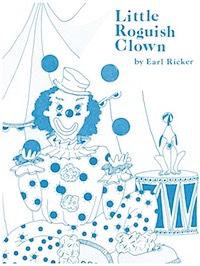By Earl Ricker
Capricious rhythmic elements ‑‑ quarter rests for downbeats (mm. 2, 4, etc.) and a teasing pause on a fermata (rn. 25) ‑‑ give this lively piece an impish quality. To get acquainted with the music, students may clap and count main rhythmic patterns. A student and teacher (or two or more students), may then play alternate measures, answering one another back and forth.
––––––––
Some "Building Blocks" for students to discover and explore:
• Section A, m's 1‑8: Playful ‑‑ C major tonality; MF and F, peppy staccato and slurred articulations with punctuating minor seconds (mm. 4 and 8).
• Section B, m's 9‑16: Doleful ‑‑ A minor tonality; F, legato, slurred minor second melody motif; chromatic fragment (mm. 15‑16) leads back to playfulness of Section A.
• Section A, m's 17‑22: Repeats opening through m. 21.
• Coda, m's 23‑26: Helpful in negotiating last line, for student to note
that m. 24 (beats 3‑4) and m. 25 (beats 1‑2) repeat m. 7, adding F#.
Creativity: As with all the other compositions in the Pace Recital Series, endless creative activities relate to this piece. In a class setting, for instance, let students act out the role of "circus clowns" to the music, as one student (or the teacher) plays Little Roguish Clown.
After one or more turns at this, ask students to tell about what some things are that clowns do in circus acts, and how and why. Ask students to think about how a "jump" or a "fall," etc. might sound on the piano. Then, ask each student to play his or her own musical version of these things. Alternately, have a student play a representation of something the clown does, and let the other students take turns guessing what was "going on." After students have "gotten the idea" about expressing images and ideas through music, ask them to improvise or compose their own clown "story" at home, on the piano.
At the next lesson, let students share their musical "stories," perhaps having listeners guess what each other's music is "about." Before each student plays, ask each classmate to listen for what kind of musical "devices" (staccato, legato, loud, soft, fast, slow, high, middle, low, leaps, steps, etc.) are used in the piece. After the piece is played, ask students to identify what kinds of musical "devices" they heard, and encourage them to tell about what "pictures" these create. At the end of the lesson, students may enjoy acting out clown roles, as various classmates accompany the class on the piano.
Excerpted from TEACHING TIPS, by Dr. Cynthia Pace. © All Rights Reserved.

















